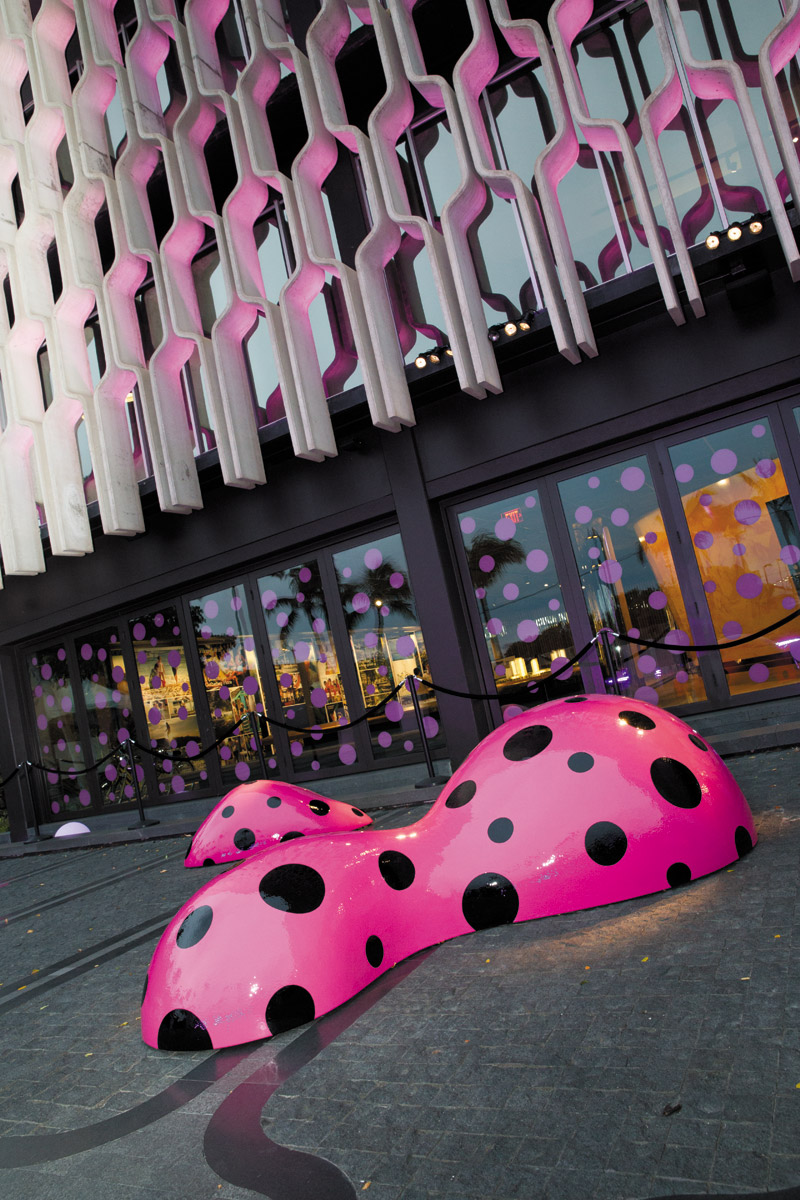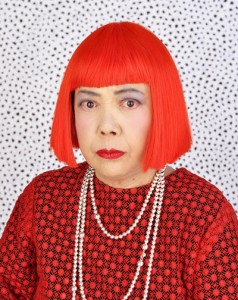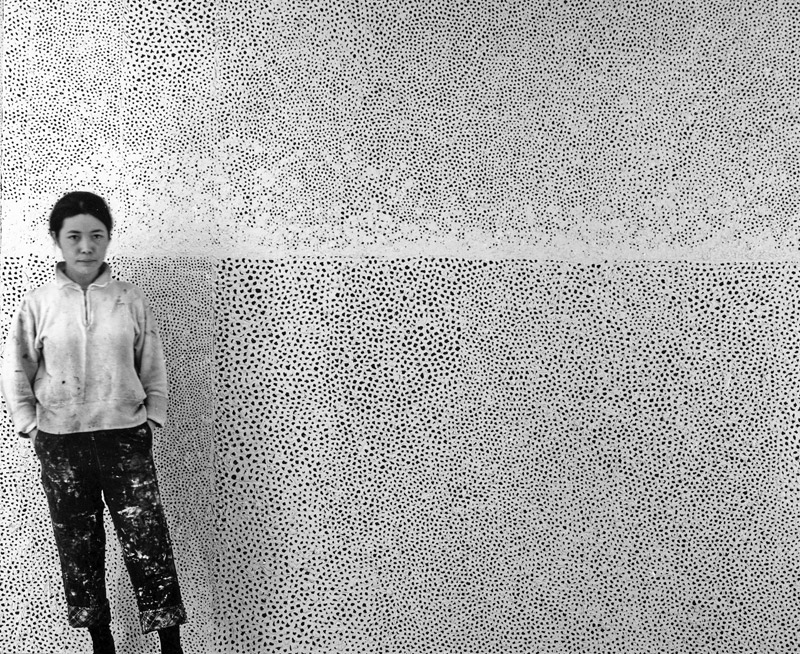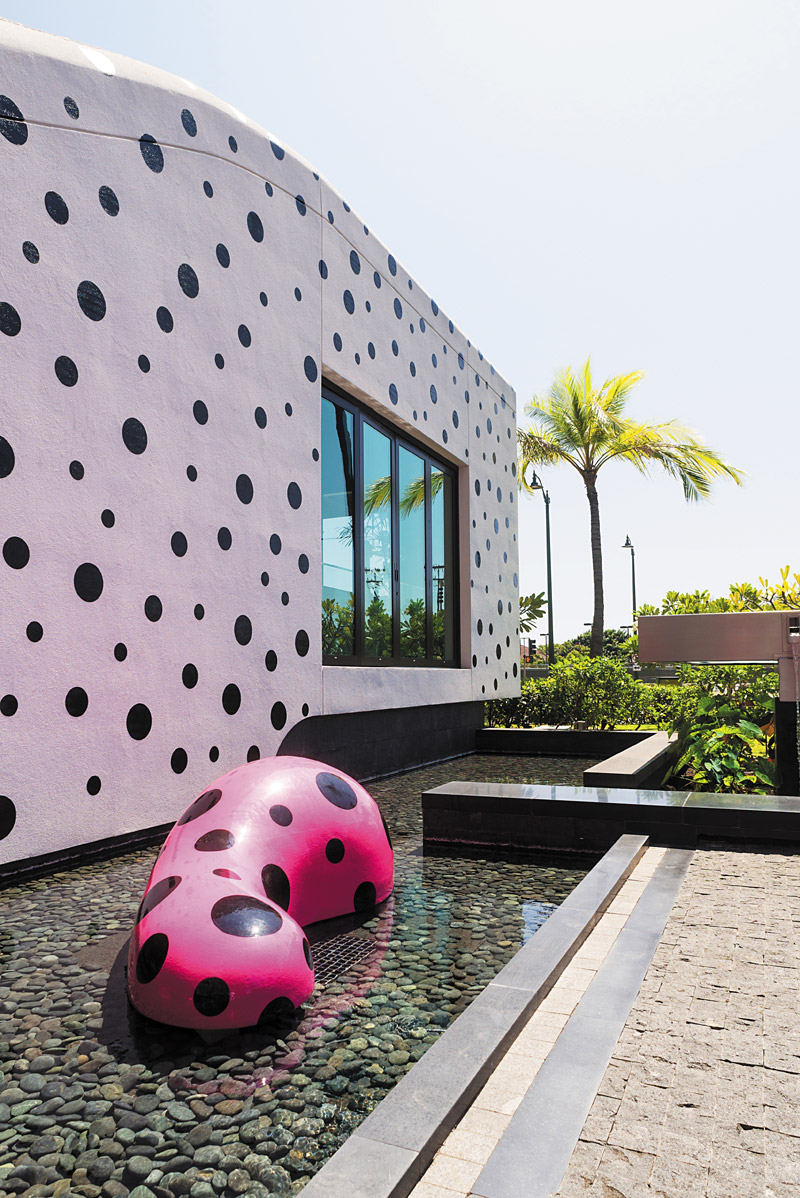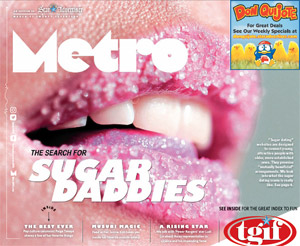Leaving ‘Footprints’ On The Local Art Scene
In the 1960s, Japanese artist Yayoi Kusama moved to New York City and promptly made a splash in the avant-garde scene with her use of vibrant colors, hallucinatory images, and sometimes controversial works — polka dots painted on naked men and women in public places, hundreds of phallic sculptures clustered together.
After later moving back to Japan, she fell off the radar for some time, but in more recent years, she has re-emerged with numerous high-profile exhibitions. By 2014, Kusama had been named the world’s most popular artist according to a survey in museum attendance conducted by The Art Newspaper.
And now — for the first time publicly in Hawaii — a piece by Kusama is on display locally: Her 15-piece sculpture Footprints of Life currently is set up in the Ward Village Courtyard through May 13.
The installation comes to the Islands through the efforts of the Honolulu Biennial Foundation (HBF) as a precursor to the inaugural Honolulu Biennial, a contemporary visual arts festival. The Biennial is slated to run for eight weeks starting in March 2017, but in the meantime, HBF is hosting a number of events to drum up an audience and offer community-focused programming.
The brainchild of three local professionals — physician and curator Dr. Koan Jeff “KJ” Baysa, art critic and curator Isabella Ellaheh Hughes and international development consultant Katherine Tuider — the Biennial is a way to raise awareness about Hawaii-based art on the international level, as well as support the careers of local artists. The main event next year will feature works, including some new commissions, by local artists alongside national and international artists, and will entail workshops, lectures, tours, panels and more.
“We really want to be part of this global arts infrastructure that for far too long, Hawaii has not been part of,” Hughes explains. “We really hope to reposition Hawaii on the world stage as a leading arts center — and to raise awareness of our talents.”
The seed for the Honolulu Biennial was planted a few years ago, when Hughes curated an exhibition depicting work by Hawaii artists at The Smithsonian’s National Museum of the American Indian in Washington, D.C. But when people came in, they would ask: Where is all the Hawaiian art?
“What they were hoping to see, I think, were these very, very problematic colonial and voyeuristic images — which the few times that visual culture tends to be exported in mass outside of Hawaii, is what you get,” Hughes says.
Hughes, Baysa and Tuider all have lived and worked for years on the Mainland and abroad — and they’ve all found that those sorts of preconceived notions and general lack of knowledge about Hawaiian art were the norm.
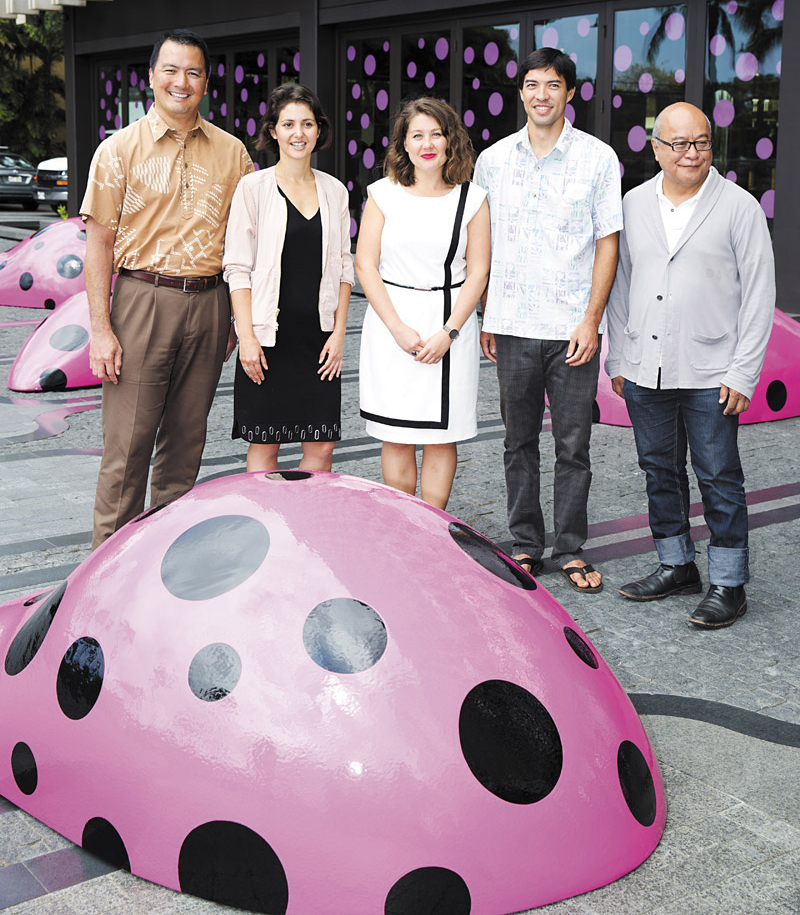
(From left) Vice president of community development at Ward Village Todd Apo, Honolulu Biennial Foundation co-founders Isabella Ellaheh Hughes, Katherine Tuider and (far right) Dr. Koan Jeff “KJ” Baysa, and artist Charlton Kupa‘a Hee MISSY ROMERO PHOTO
“Having access to this global conversation in art and then seeing how left out of the conversation Hawaii is, we felt deeply that needed to be changed,” Hughes says. That, they say, is where they see Honolulu Biennial playing a pivotal role. Biennial and triennial arts festivals take place in cities like Venice, Liverpool and Sao Paulo and commonly attract hundreds and thousands of visitors — while netting millions of dollars for the host countries. (HBF has projected that Honolulu Biennial will bring in about 42,500 out-of-state visitors.)
HBF also hopes that attracting a global audience will support the livelihood of local artists.
“(Local artists) are doing amazing things here and can hold up to any international artist, yet they don’t have the same kind of recognition,” Tuider says. “A lot of the artists that we know practicing here have to work one, two or three separate jobs, and that is exhausting and takes away from the (artistic) process.”
The Kusama installation is just one of a number of events leading up to the inaugural Honolulu Biennial. HBF hosts an ongoing lecture series with art professionals and has been making the rounds at national art festivals to promote the event.
HBF still is in its research and curating phase, but it recently revealed a partial list of participating artists. Kusama is among them.
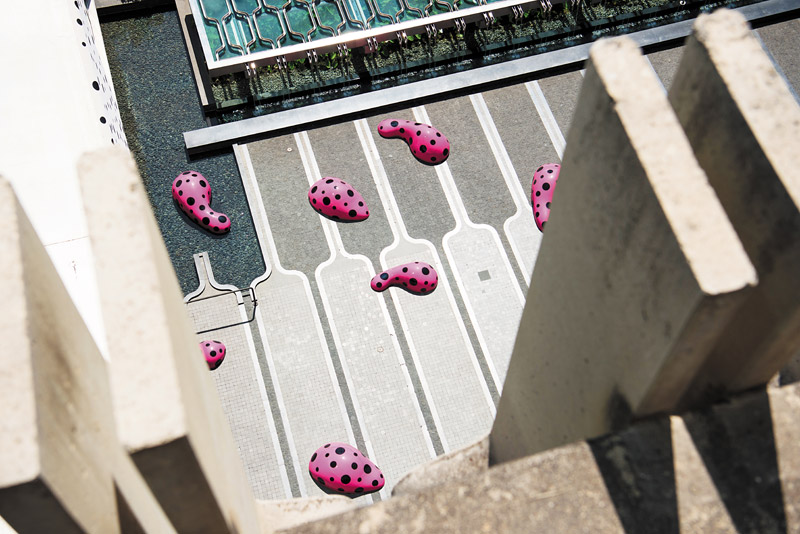
An aerial view of Yayoi Kusama’s ‘Footprints of Life’ at the Ward Village Courtyard in the IBM Building
AJ FEDUCIA PHOTO
“(Kusama) was an excellent way to introduce what’s to come in 2017 because she’s such an iconic artist,” explains Tuider.
According to Asian Art Mu seum of San Francisco director emerita Emily Sano, Kusama is “one of the most significant artists working today.”
“She has been constantly in the public view since the 1990s,” says Sano, who will be giving a talk on Kusama April 13 at Ward Village. “There has been show after show after show. She is very prolific.”
Raised in Japan, Kusama pursued her interest in art from a young age, despite objections from her conservative family, who would have preferred that she settle into her expected role as a housewife.
After initial struggles, Kusama did achieve success in New York — she counted Andy Warhol among her contemporaries, and at one point, competed with him for press mentions. Her art spans a range of mediums — painting, sculpture, performance and poetry — and she is particularly noted for her, as Sano describes it, “obsessive, repetitious” works that depict the same patterns over and over. Polka dots, a prominent feature in the Ward Village installation, especially are a hallmark of Kusama’s.
Kusama has stated that she’s experienced hallucinations since childhood, and these dots and patterns are how she sees the world. Sano also theorizes that Kusama’s work is her way of addressing her fears and escaping her anxieties.
Kusama returned to Japan in 1973 — possibly, many art historians postulate, as the result of physical and emotional exhaustion. (“She must have gotten extremely strung out during the ‘60s and ‘70s in New York,” Sano explains. “She was a foreigner and didn’t have a lot of money and was working furiously.”) She soon after checked herself into a mental institution, where she still lives today. But right down the road is her studio, where she continues to create, and she is constantly producing new pieces.
In conjunction with the Kusama installation, HBF and The Howard Hughes Corporation have a number of related events lined up (see sidebar on the previous page) in partnership with various community groups and local businesses.
It’s that community-focused aspect that prompted Ward Village to partner with HBF for the installation.
“We are looking at what are the different elements of creating a community — it’s not only the towns that we are building,” says Ward Village’s vice president of community development Todd Apo. “It’s also the activities that we are creating around this area.”
The level of community-wide collaboration with the Kusama installation is indicative of Honolulu Biennial as a whole — for the 2017 event, they’re looking to partner with other arts organizations, businesses and galleries. It’s about, as Hughes explains it, transcending barriers and making art accessible to everyone.
“We think it is going to be advantageous holistically for the community, as well as our economy,” Hughes says.
For more information, visit honolulubiennial.org.
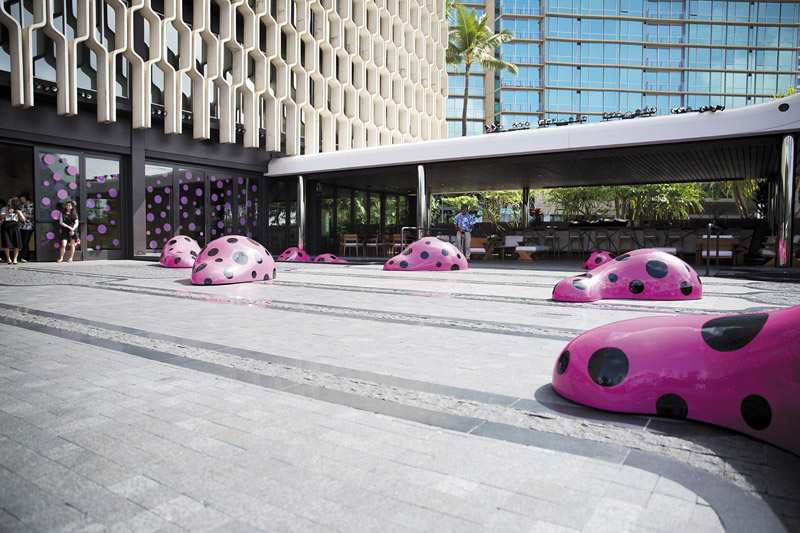
CONNECTING THE DOTS
Ward Village and Honolulu Biennial Foundation have a number of free community events lined up in conjunction with the Yayoi Kusama installation. Below is a partial list. (Note: Other than Art+Flea, all events take place in the IBM Building courtyard.)
“It was really important that we didn’t just do an installation, that we also found ways to make it really accessible and make everyone feel welcome and excited about it,” explains Honolulu Biennial Foundation co-founder Katherine Tuider.
Keiki for Kusama, March 12
Kids have the opportunity to take part in a Kusama-inspired arts and crafts session with Art Explorium from 3 to 5:30 p.m.
Art + Flea, March 31
Art+Flea themes its next monthly event “Peace, Love, Yayoi, Forever,” from 5 to 10 p.m. at Ward Warehouse.
Lecture Pau Hana, April 13
Asian Art Museum of San Francisco director emerita and Coates-Cowden-Brown senior advisor for Asian Art Emily Sano discusses “Yayoi Kusama: The Woman Behind The Dots” from 6 to 7 p.m.
Courtyard Cinema, April 14
This installation of Ward Village’s Courtyard Cinema screens a documentary on Kusama, Yayoi Kusama: I Love Me, starting at 6 p.m.
Keiki For Kusama, April 16
Here’s another chance for keiki to interact with the Kusama installation, this time with a Polka Dot Creatures Workshop from 3 to 4:30 p.m.
Talk Story, April 22
Local artist Charlton Kupa‘a Hee talks about his work from 6 to 7 p.m.
Throughout the installation’s run, Ward Village also will be continuing to host its regular events, including weekly yoga and the monthly Sunday brunch, amid the sculpture. There also will be free sunset tours of the installation every Monday. For a full list of events and more information, visit honolulubiennial.org.

